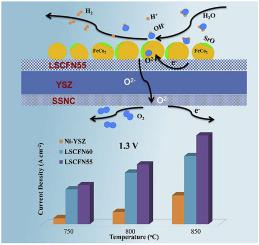Materials Today Energy ( IF 9.0 ) Pub Date : 2020-06-14 , DOI: 10.1016/j.mtener.2020.100458 Zhongyang Teng , Zhuru Xiao , Guangming Yang , Lei Guo , Xiaoqing Yang , Ran Ran , Wei Wang , Wei Zhou , Zongping Shao

|
Steam splitting using solid oxide electrolysis cells (SOECs) is highly attractive for mass production of high-purity hydrogen, while its economic competitiveness strongly relies on the availability of low-cost, active and stable hydrogen electrodes. Here, we report an A-site cation-deficient La0.4Sr0.55Co0.2Fe0.6Nb0.2O3-δ (LSCFN55) perovskite is such a hydrogen electrode for SOEC, exhibiting a high electrolysis current density of 0.956 A/cm2 with an applied voltage of 1.3 V at 850 °C and good stability in a high humidity and hydrogen partial pressure environment. The introduction of A-site cation deficiency into the perovskite oxide lattice of LSCFN55 promotes the exsolution of partial cobalt and iron from the oxide bulk with the formation of Co2Fe alloy nanoparticles that decorate the surface of perovskite main phase, simultaneously SrO is segregated to form nanocomposites with the alloy. The outstanding electro-catalytic activity of alloy nanoparticles, the favorable water adsorption capability of SrO, the high oxygen-ion conductivity of the perovskite main phase, and the improved electronic conductivity of the material, cooperatively contribute to the superior performance of the electrode. The strong interaction between the alloy nanoparticles and the perovskite substrate effectively suppresses the sintering of the nanoparticles while the SrO phase protects the alloy nanoparticles from oxidation, both then contribute to the high operating stability of the electrode.
中文翻译:

利用新型氢电极通过固体氧化物电解槽有效地将水分解,该氢电极衍生自A位阳离子不足的La 0.4 Sr 0.55 Co 0.2 Fe 0.6 Nb 0.2 O3 -δ钙钛矿
使用固态氧化物电解池(SOEC)进行蒸汽裂解对高纯度氢气的大规模生产极具吸引力,而其经济竞争力则强烈依赖于低成本,活性和稳定的氢气电极的可用性。在这里,我们报道了A位阳离子不足的La 0.4 Sr 0.55 Co 0.2 Fe 0.6 Nb 0.2 O3 -δ(LSCFN55)钙钛矿就是这种SOEC氢电极,表现出0.956 A / cm 2的高电解电流密度在850°C时施加1.3 V的电压,在高湿度和氢分压环境下具有良好的稳定性。将LSCFN55的钙钛矿氧化物晶格中的A位阳离子缺乏引入可促进部分钴和铁从氧化物块中脱出并形成Co 2。装饰钙钛矿主相表面的Fe合金纳米颗粒,同时SrO分离与合金形成纳米复合材料。合金纳米粒子的出色电催化活性,良好的SrO吸水能力,钙钛矿主相的高氧离子电导率以及材料的改善的电子电导率共同有助于电极的优异性能。合金纳米颗粒与钙钛矿基质之间的强相互作用有效地抑制了纳米颗粒的烧结,而SrO相保护合金纳米颗粒免受氧化,因此两者都有助于电极的高操作稳定性。











































 京公网安备 11010802027423号
京公网安备 11010802027423号